It’s all the podcasters’ fault. At least, that seems to be the narrative progressing from David Gordon Green’s 2018 Halloween reboot to its covid-delayed sequel, Halloween Kills—that there’s a straight line from Jefferson Hall’s true crime podcaster shaking the Michael Myers mask in the man’s face, roaring for a reaction to the first generation of Michael’s surviving victims taking up baseball bats, screaming “EVIL DIES TONIGHT!” and seeking to… unmask Michael Myers? What seems intended as a redemptive sequel about a town exorcising its Bogeyman instead turns into The Purge: Haddonfield and sacrifices one of its best new characters in a perfect demonstration of the problem with middle-movie syndrome.
This piece contains spoilers for Halloween Kills.
To be clear, introducing a pair of true crime enthusiasts was the note-perfect way to reboot Halloween as a contemporary horror film about how trauma reshapes three generations of women: It starts the action several degrees removed from the people actually affected, with two strangers granted face-to-face access to the Bogeyman when he’s just a middle-aged man in chains. Over the course of Green’s insightful, self-aware film, longtime fans and newcomers alike got to ease closer to Laurie Strode (Jamie Lee Curtis), daughter Karen (Judy Greer), and granddaughter Allyson (Andi Matichak), until we were intimately involved as they overcame their respective hangups and fears in order to trap Michael in the same cage of fear in which they were supposedly contained.
That’s why the decision to re-expand the scope of Halloween Kills to encompass the town of Haddonfield (bringing back actors and characters from the 1978 original to lead a shoehorned-in plot about mob justice) is so baffling and ultimately alienating. Between clogging the sequel with too many new-old voices and splitting up the Strode women—not to mention having the gall to sideline Jamie Lee Curtis for most of the movie!—Halloween Kills comes across as random and meandering as Michael’s movements after he emerges from Laurie’s fiery compound.
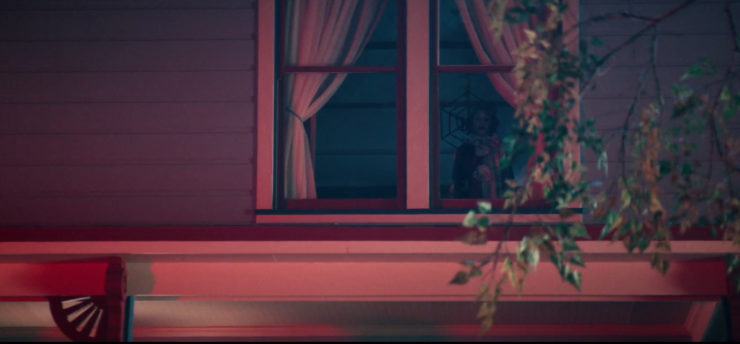
Or… is Michael reenacting his own trauma and everyone is just getting in his way? If you can believe it, Halloween Kills will make you root for the Bogeyman just as much as for his victims.
But back to Halloween’s podcasters Aaron Korey (Hall) and Dana Haines (Rhian Rees): Their entitlement to Michael and Laurie’s story and their belief that a fresh perspective will exhume some new insight, is what encourages Dr. Sartain (Haluk Bilginer) to break Michael out of prison and drive him straight to his terrorized prey—a Laurie who has transformed into a predator at great cost to any semblance of a normal family dynamic. That chain of events, and the resulting Halloween massacre 40 years after the first, is what sparks the powder keg of trauma for everyone in Haddonfield who wasn’t Laurie, namely three grown-up children who discovered that their babysitters couldn’t protect them from the monster under the proverbial bed: Tommy Doyle (Anthony Michael Hall), Lonnie Elam (Robert Longstreet), and Lindsay Wallace (Kyle Richards). Joining them are Officers Hawkins (Will Patton) and Brackett (Charles Cyphers), each with their own regrets about not killing Michael when they had the chance, and survivor Marion (Nancy Stephens).
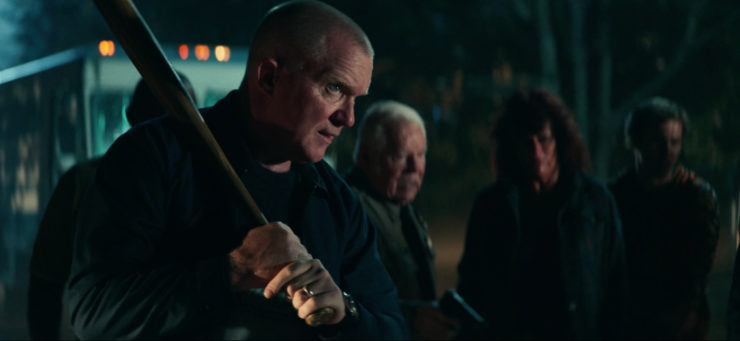
If Aaron and Dana had survived their gas-station encounter with Michael, you know they would have tracked down these half-dozen primary sources to lend texture to their production. Instead, the people who lived through the terror firsthand reject the police’s attempt at order—believing the law has failed to contain Michael—and create a hysterical mob that relies on a grisly game of telephone that winds up with the wrong inmate dead. A mistaken sighting from a short-lived new Black character (Michael Smallwood) who doesn’t even know what Michael looks like leads to chasing the other escaped inmate both to the hospital—where a bed-bound Laurie is convinced Michael is coming for her—and then off the roof of said hospital rather than be torn apart by a seething, hateful mass of its own brand of evil.
Green and cowriters Scott Teems and Danny McBride were no doubt leaning hard on the nostalgia factor, but their attempt at tapping into the Halloween legacy undermined the flawless formula they had already built up in the first movie. Halloween Kills should have stuck with the Strode women instead of splitting them up: Laurie, despite her best efforts and Curtis going all action-movie stabbing herself with morphine, stuck bleeding out in a hospital; Ally, grabbing a rifle from boyfriend Cameron’s (Dylan Arnold) dad Lonnie so she can join the mob; and Karen, flitting uselessly back and forth between her mother and her daughter, still struggling to process the brutal murder of her husband mere hours ago on top of the gutting realization that her greatest fear has come true: her mother was right.
Greer’s performance as Karen brought us the best moment of Halloween, in which this mom in her uncool Christmas sweater let Michael and the audience think that she had failed to internalize Laurie’s intensive survivalist training, that when faced with the Bogeyman she would regress into sobbing, paralyzed terror—and then when he got close enough, she shifted into badass mode and shot the motherfucker. She hated that her mother was right, but she also knew exactly how the situation required her to respond. The sequel completely fails to live up to this brilliance, instead using Karen as the literal embodiment of the middle movie of a trilogy: save for rare exceptional cases, a narrative bridge between the introduction and conclusion of this triptych, a means to an end.

So when Karen yanks off Michael’s mask and taunts him to come get her (“I’m an innocent woman, just like your sister was!” which doesn’t quite track), it feels like she’s speaking on a meta level: This sequel is being sacrificed for the sake of linking the poignant reimagining of Halloween to the it-better-be-worth-it conclusion of Halloween Ends, so both Halloween Kills and Karen herself are collateral damage. And yet she doesn’t die in this moment, instead luring an unmasked Michael out to the waiting mob, led by Tommy Doyle with his childhood bat and Officer Barrett with the one-liner he’s spent four decades polishing: “It’s Halloween, Michael. Everyone’s entitled to one good scare.”
This final confrontation is where Halloween Kills is at its most befuddling, trying to wear too many narrative masks. Alongside the ridiculous “EVIL DIES TONIGHT” mantra is an obsession with unmasking Michael, as if such a thing (a) would strip him of his power and (b) has never been done before. Teenage babysitter Laurie Strode unmasks him in 1978! Dr. Sartain and the rest of the correctional facility see his mug every day! The podcasters lay eyes on him and live to tell the tale (until they don’t)! This isn’t Scream—who’s under the mask is not a mystery. Haddonfield knows exactly what Michael Myers looks like, whether he’s lurking behind that iconic expressionless shield or whether he’s bare-faced and staring sidelong from the steps of his childhood home at the people who seem set upon taking him down once and for all.
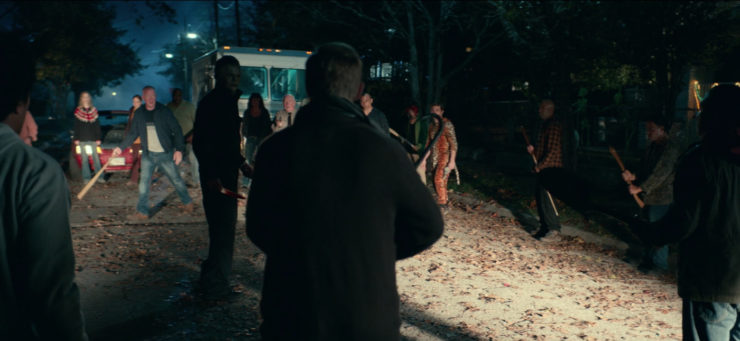
If anything, the Myers home is more pivotal to the story than a damn mask. Multiple characters bring up the same anecdote, about young clown-costumed Michael staring out from his sister’s bedroom window upstairs—one of the house’s two “eyes”—searching for something. Young Officer Hawkins’ (Thomas Mann) dead partner and Karen herself step up to this same spot, putting themselves in Michael’s footsteps and raising the question of whether he was looking out, as they had always assumed, or staring at his reflection in the glass. If you squint, Halloween Kills seems to be less about unmasking the Bogeyman than in unmasking ourselves—that is, our own worst and most primal impulses, the bloodthirst that leads us to kill, either directly or indirectly through a mob’s rage.
The flipside of that self-reflection is that Halloween Kills appears to posit that Michael… might not be as evil as they’re saying? Hawkins and Laurie, bonding over their sidelined injuries, seem to agree that Michael is not in full control of his faculties: “He’s a six-year-old boy with the strength of a man and the mind of an animal,” he says, to which she immediately responds, “I know, I’ve seen his face.” Across town, Ally is in the car with Cameron and Lonnie, who traces Michael’s route from Laurie’s compound back to the Myers house as if to describe that the Shape is less targeting specific victims than cutting down whoever is unfortunate enough to cross his path: “He creeps, he kills, he goes home.” To wit, all the mob does is rack up Michael’s body count for him: All of these OGs would likely have made it through the night safe if they had simply stayed out of his way.
But we can’t ignore the fact that when Michael does kill, he’s incredibly deliberate with how he arranges the bodies: Plucking kitchen knives to thrust into the back of Phil’s (Lenny Clarke) corpse while his poor wife Sondra (Diva Tyler) looks on. Recreating Big John (Scott MacArthur) and Little John’s (Michael McDonald) sweet couples photo in reverse. Adding insult to the injury of murdering Cameron by twisting his head around to break his neck—that was just unnecessary.
(As an aside: RIP Big John and Little John, who deserved a better fate than playing Marco Polo with their own bizarre monikers as they tried to evade Michael simply for having the bad luck of probably getting a great deal on his murder house as their cozy abode. Especially when they were introduced by getting tricked by a bunch of trick-or-treaters using the old razor blade urban legend, and turned it around on those little shits by conjuring the Bogeyman right in front of the house. In a film with too many unnecessary satellite characters, these legends stood out.)
“Fear—people afraid—that is the true curse of Michael,” Laurie says in her final speech, which does no one any good since its only audience is Hawkins in the hospital. But she doesn’t lay the blame on him, continuing the thought to its more uncomfortable and self-interrogating conclusion: “It is the essence of evil—the anger that divides us. It is the terror that grows stronger when we try to hide. If they don’t stop him tonight, maybe we’ll find him tomorrow—or next Halloween, when the sun sets, and someone is alone. You can’t close your eyes and pretend he isn’t there, because he is.”
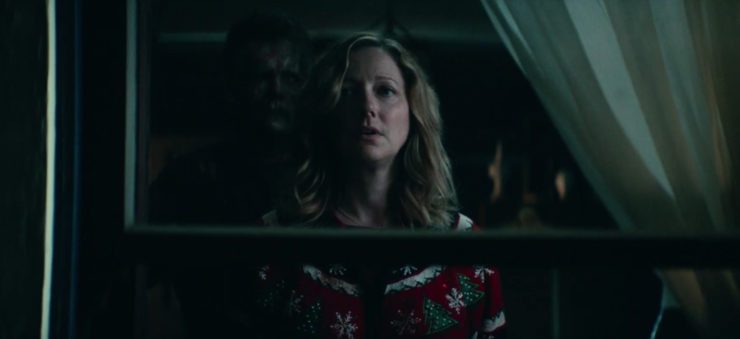
It’s this insistence on reflections, on willing an explanation to come from a transparent surface if you only look hard enough, that ultimately gets Karen killed. Rather than watching Michael finally die at the hands of the mob, she goes to his childhood bedroom to try, as so many others have failed to do, to understand what makes him stalk and kill the way he does. And so she’s not there to see him rise up and kill Tommy, Brackett, and the others—which at this point, we might even be rooting him on?—and finish his Halloween path to the same spot, where she’s standing in the way of his reflection.
Green and Curtis have begun hinting at what’s to come with Halloween Ends (currently set for an October 22, 2022 release), both narratively and thematically. According to the director, the final installment will jump to present-day and incorporate the additional trauma of the covid pandemic. Curtis’ recent roundtable commentary would seem to tie into what Halloween Kills was trying to set up by forcing the people of Haddonfield to reflect on what they might have in common with Michael: “There’s a phrase in recovery where you’re looking in the mirror,” Curtis says, “you’re looking at the problem, and I think we’re going to be looking in the mirror a lot in the next movie.”
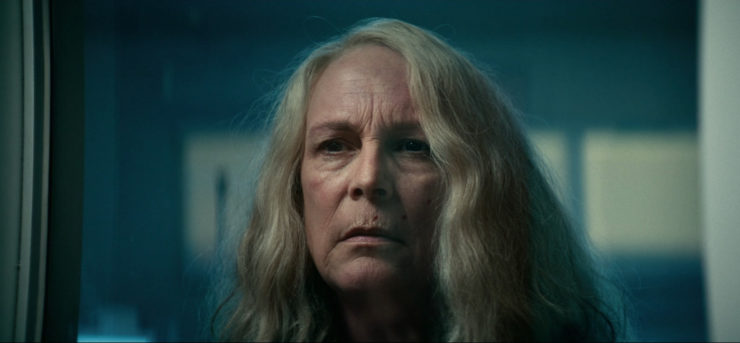
They just better be looking over their shoulders, too.
Halloween Kills is in theaters and streaming on Peacock Premium.
Natalie Zutter is still holding out hope that Halloween Ends will bring it all home. Talk horror reboots and the good true crime with her on Twitter!










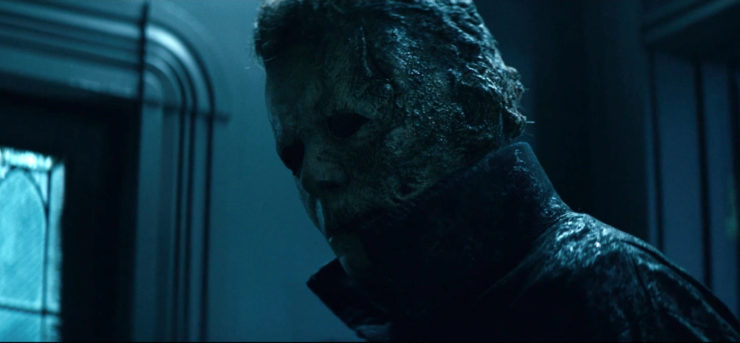
I think there’s probably no more muddled message that could be given in 2021 than making the mob of crazed vigilantes and lunatics going after a child-killing monster who the police are utterly unable to stop. Especially as the first movie established that crazy militia-woman and Sarah Connor stand-in, Laurie Strode, was proven 100% correct. Yes, the mob of crazy militia are unable to stop Michael Meyers but they are justifiably right to WANT TO.
As for Michael Meyers, he’s either a bog standard serial killer and escaped mental patient or he’s a a supernatural avatar of evil. Neither of which affords him any sympathy. Doctor Loomis is surprisingly one of the rare competent psychiatric professionals in media and he did make an incredible effort to treat Michael for eight years. It’s just Michael is evil not insane. It’s the mistake the podcasters make as they try and treat him as a misunderstood monster or “both sides” the conflict with Laurie Strode when it is as far from a gray and grey conflict as possible.
Hell, one of the best moments of the previous film is the realization Laurie Strode has waited decades to fight Michael again and Michael arrived at her house completely by accident and doesn’t actually recognize her. He’s not chasing his long lost sister or any magical vendetta–he just wound up at her house because it’s a small town and you eventually will end up crossing paths.
@1. C.T. Phipps: I’ve not yet done more than glance at this franchise, but this being Horror Fiction (and more particularly Slasher fiction) it’s perfectly possible for Michael Myers to be both a spree killer escaped from a lunatic asylum AND an Avatar of Evil – after all, even Supernatural Evil need not be blatantly Supernatural.
Also, every review of this film makes me suspect that (like the New Line HOBBIT movies or the BBC Dracula of 2019) this is a series that might have done better to stick to two films, rather than stretch the story (and its luck) to breaking point with three.
Have still not seen this film as yet, but this article DID persuade me to watch its immediate predecessor when that appeared on local TV.
It was quite good, especially when The Furies came a-calling for Michael Myers (though why they needed a sequel to such a perfect ending is beyond me; perhaps they would have done better to make a second stab at the anthology format – same genre, same world, different characters).